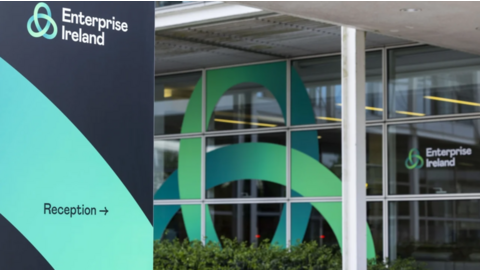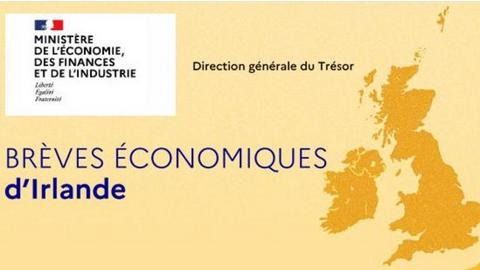Sectors & markets
Irish construction rises on data centre strengths

The Irish construction sector continues to rise, propelled by blistering investment in the country’s data centre industry. In the decade ending in 2016, approximately €3 billion was invested in constructing data hosting facilities.
At the Global Data Centre Forum, Enterprise Ireland, the trade and innovation agency, brought international delegates together with local companies to uncover burgeoning opportunities in the country’s data centre sector.
In 2017, Host in Ireland, working with digital and energy research firm bitpower, calculated that an additional €3 billion would be invested by 2019, representing a 333% increase in annual investment. In the latest Host report for Q3 2019, per annum investment was revised upward to €1.3 billion for data centre build – an impressive acceleration.
A 2018 study of benefits delivered by the data centre industry estimated a contribution of €7.13 billion to the Irish economy since 2010. Based on a survey of industry players, it found that 93% expect to maintain or increase data centre investments over the coming decade. Measured as percentage of value add to the economy, Ireland’s ICT sector as a whole is the highest performer across developed countries, according to the latest OECD data, an important contributor to the country’s ongoing economic health, which has surprised those concerned about the Brexit impact.
What is the source of this vigour? And what accounts for Ireland’s ability to punch beyond its weight in the information technology sector?
At the Global Data Centre Forum, held in conjunction with the Data Centres Ireland trade show in Dublin, Enterprise Ireland brought delegates from the Canadian, US and European data centre industry together with Irish counterparts to explore this question – and the potential for new partnering opportunities in the space.
Irish data centre environment
A visit to Silicon Docks – the area around Dublin’s Grand Canal Dock that stretches to the International Financial Services Centre (IFSC) special economic zone that was established in the late 1980s to stimulate economic development – tells part of the story.
The reference to California’s high-tech hub reflects the concentration of technology companies, such as Google, Facebook, Twitter, LinkedIn, Amazon, eBay, PayPal and Microsoft, present in the Docks area. Many of these hyperscalers have established European headquarters in Dublin and continue to expand data centre footprint in other regions of the country, while other centres such as Limerick and Cork host companies including Apple, EMC and Johnson Controls.
Other advantages that have attracted international organisations include a temperate climate that enables the energy efficiencies brought by free air cooling, relatively cheap real estate costs, a ready supply of educated, local workers to manage facilities, and a network of 11 submarine cables that connect Ireland to the US, and to other European countries, positioning Ireland as a data bridge between Europe and America.
This international investment has provided an important stimulus to the development of local Irish capability. As Stephen Hughes, department manager for construction at Enterprise Ireland, noted in his welcome to delegates at the Global Data Centre Forum, the speed of change in this sector has been rapid, and Ireland has “done well in building mission critical infrastructure, learning from international partners.”
According to Dermot Reidy, senior advisor for construction at Enterprise Ireland, advanced design capabilities mean that Irish general management and contracting companies are attracting orders in the range of €250,000 – €1 billion, the country having developed a niche in the construction of hyperscale and colocation facilities. Approximately 40% of global data is held in Ireland, Reidy claimed, in facilities designed and built in Ireland.
In a preview of the latest Host report, David McAuley, founder and CEO of bitpower, provided additional detail on the Irish data centre industry. In addition to Microsoft, AWS, and the hyperscalers noted above, Ireland is also home to several key colocation providers. CyrusOne, Digital Realty, Equinix and EdgeConneX, for example, have located data centres in the “Digital Isle.”
It is also host to several smaller enterprise facilities, such as telco data centres at ½ MW of power. According to McAuley, there are now 54 data centres in Ireland with 600 MW capacity: of these, approximately 75% are hyperscale facilities, 12% are colocation, and the remainder are smaller enterprise.
On the island, Dublin is the predominant data centre hub, with three clusters around the airport, the west and south west regions, which benefit from connectivity provided by the 44-kilometer T 50 fibre network that rings the city. Based on permit approvals, McAuley estimates that there are an additional 31 data centres in the planning phase, which will add an additional 1500 MW of capacity.
Powering growth
A precondition of this growth is adequate energy supply. National grid operator EirGrid has stated that data centres could account for 31% of Ireland’s total energy demand by 2027. According to a report by the Irish Academy of Engineering, a €9 billion investment in Ireland’s power networks and infrastructure will be needed between now and 2027 to cope with the data centre community’s energy demand – particularly in the greater Dublin area, which services hyperscale facilities operated by AWS, Microsoft and Google.
As concerns over Ireland’s ability to meet its carbon reduction targets increase, a growing requirement is for clean energy that can be accessed via the utility grid. While there are currently no plans to call on major data centre players to contribute to grid renewal, there is evidence that large international firms such as Google are investing in their own sustainability programs, which may include direct access to wind farm resources from data centres.
Beyond building new capacity, another approach to ensuring adequate and sustainable energy supply lies in consumption reduction. At the Data Centre Forum, InsightaaS led a panel of international thought leaders as they explored opportunities to drive sustainability in the data centre industry.
Ruairi Barnwell, energy services leader with the DLR Group, Anand Mohammed, data centre operations manager with Cologix, Lane Anderson, EVP, development and strategic procurement for QTS Data Centres, and Michael Cohen, director of strategy and development for APL France, responded to business objectives, best practices and metrics questions on key issues in data centre management, including:
- Ruairi: How can carbon neutrality and climate action goals figure in data centre planning, and how are sustainability investments justified? Can data centre providers leverage sustainability to differentiate in competitive North American markets? What is a reliable, broadly accepted indicator of success – PUE or LEED?
- Michael: The simple equation, greater efficiency = energy savings = environmental benefit, is no longer adequate to describe all data centre scenarios. What other approaches to sustainability must be considered, and given multiple environmental impacts, how is it possible to create a consistent, unified sustainability strategy? When there are multiple KPIs, how can these map to a lifecycle approach that unifies disparate metrics?
- Anand: What are the ‘twin ecos’ in data centre operation? What techniques or activities deliver the best payback in terms of time saved, cost savings or carbon benefit? And how does the operator know he/she is on track to meet sustainability targets?
- Lane: How do older facilities fit into sustainability objectives that may be developed for a large data centre fleet? How can pathways to sustainable operations – using renewable energy, for example – be extended across the portfolio? Is it possible to use the same sustainability metrics in greenfield and brownfield opportunities?
Building export capability
Design, construction and operational learnings have helped to drive data centre build on a local level, but also enabled the development of international delivery capability. According to Hughes, the result is two-way trade that now encompasses the delivery by Irish companies into North American markets.
Elaborating on this theme, another InsightaaS-led panel helped the international audience to understand how, where and why Irish data centre suppliers develop business relationships with international partners. Mark Gillet, senior director, mission critical at PM Group, John Coroner, executive director of Ethos Engineering, and David Byrne, bid director at Mercury – three firms active in the construction, engineering, and project management space – described how they help overseas businesses navigate the Irish and European markets.
Panelists described several different ways that their firms have helped North American firms to succeed in the EU. Byrne noted that “customers are looking for cookie-cutter replicas of data centres” built in other regions, but that local regulations and requirements may make this impossible; even within the EU, countries have different safety standards and other requirements that must be accommodated. Additionally, labour markets vary from country to country, and a knowledgeable partner can help guide offshore firms to the right sources of tradespeople. Local firms also have a detailed understanding of how to navigate GDPR requirements in Ireland and on the continent. Lastly, Gillet explained, local firms with deep roots have built trust in market that helps to “take the pain away” – by providing Irish expertise on permitting and other issues to global firms.
Irish providers
A key goal of the Forum was to introduce Irish businesses in the construction and data centre industries to international delegates, catalyzing the discussions that can underpin mutually beneficial partnerships. The diversity and breadth of companies in the Irish data centre supply chain represented at the Forum bode well for the development of these kinds of relationships. A not exhaustive sample of these 25 firms includes:
Wisetek participates in the circular economy through lifecycle management of IT infrastructure and secure data elimination for data centres and OEM clients. According to CEO Sean Sheehan, Wisetek has developed a staged approach to IT asset disposition: it begins with data cleansing, next seeks opportunities for the reuse of IT equipment, for repurposing IT components, and ultimately, if no other option is available, will provide recycle services. The company guarantees responsible recycle according to the R2 and e-Stewards global standards. Wisetek has adopted a unique business model, charging a fee for data cleansing and recycle services, but offering payment for reused equipment and a profit-sharing arrangement for repurposed components. The company works with all kinds of data centres, including hyperscalers such as Google, as well as manufacturers such as Dell and EMC. It engages in reverse logistics, and for onsite disposal maintains a fleet of six trucks in the US, which Sheehan has identified as the company’s biggest opportunity going forward. Wisetek maintains operations in Ireland, the US and Thailand.
Integrated Facilities Solutions is celebrating its twenty-year anniversary as provider of a cloud-based, secure data environment that clients may use to manage building information as assets cycle through planning, design, construction, handover and closeout, maintenance and operations. CEO Kieran Beggan described IFS services as “risk mitigation,” pointing to challenges that building projects (clients build public infrastructure, healthcare, and data centre facilities) may encounter when information is not handled properly or is simply unavailable. This issue is especially prevalent in handover and closeout, he explained. However, IFS can provide an “overall index” of documents that may include a works package, CE certification, redline drawings, training materials, as well as a safety folio that is required by regulators. IFS has helped many companies transition from paper to digital document management, and has developed its Asset Information Model – an easy access 3D BIM that provides multiple views into building documentation.
Hanley Energy – A consulting services firm, Hanley Energy covers the design, development, supply, installation and commission of turnkey critical power and energy management solutions. As head of global sales, Andrew Dobson explained: “Our value is developing solutions and our offering is about solving engineering issues in industrial manufacturing and data centre environments. We offer time, methodology, focus and skills.” Hanley Energy’s approach is total lifecycle – the company provides design, manufacture, installation and maintenance services to optimize capital costs and ensure uninterrupted power supply. “We’re not just a design house, we’re not just an electrical contractor, we’re not just an integrator,” he said. Rather, Hanley focuses on the creation of end-to-end solutions that serve as insurance policies, stretching from the power grid to the IT rack in data centre facilities. Hanley manufactures power management solutions, acting as a channel partner for several OEMs, many of these European companies looking to penetrate the North American market through Hanley’s integrated, preconfigured, modular power skid solutions. Preconfigured, these solutions simplify and speed implementation, while removing risk associated with human error, two key value propositions that address issues for customers across industries. With talent strength in industrial design, Hanley has translated much of its control switch gear and heavy consumption knowledge and expertise to the data centre world. Due to data growth, the hyperscale market is currently the more important one for Hanley.
Anord Mardix – One of Ireland’s largest and most successful data centre suppliers, Anord Mardix is a global provider of power distribution and protection equipment. Anord was a supplier of control systems based in Dundalk, which began focusing on mission critical systems in the mid-2000s. With support from a private equity backer, Anord acquired UK-based Mardix – at the time, Anord’s primary competitor – in 2018. The merged company has become a manufacturing powerhouse, with two plants in Ireland, six sites in the UK, and two others in Richmond, Virginia. Anord Mardix acts as an OEM, which the company feels makes it “a little more flexible in design and services” than some of its larger power distribution competitors. Its approach allows it to be agnostic with respect to components: Anord Mardix has worked, for example, with equipment from ABB and Eaton, responding to customer needs rather than imposing its own product specifications on integrated solutions. Anord Mardix provides skid and modular solutions, relying on offsite manufacturing and assembly to maintain high quality standards and meet demanding delivery deadlines.
GoContractor provides an innovative SaaS solution to the construction industry. Contractors struggle to ensure that all on-site workers are appropriately trained and certified, and often, critical hours are lost to on-site orientations, and compliance officers are unable to demonstrate that all job site workers have appropriate clearance for work with tools and materials. GoContractor provides a system to ensure that training, safety and compliance requirements are met in advance of the workday. GoContractor has two primary objectives. The first is to obtain and document information from workers. The GoContractor SaaS solution captures data provided by construction professionals: text fields that indicate experience, training and certification, backed by photos of training records. This information is consolidated in databases that flag exceptions: for example, a worker with an expiring credential on (for example) scaffolding will be notified that they need to update their credentials. If they fail to do so before the expiration date, the crew management will be alerted to the need to keep the worker off site until they re-certify. The second major objective is to deliver needed training before the worker arrives at a job site, and to track training delivery. This has two main benefits: it allows workers to save time and expand their personal opportunities, while enabling general contractors to demonstrate their compliance with applicable regulations. As might be expected in the diverse EU, GoContractor can accommodate multiple languages for information capture and training delivery, making it an ideal solution in environments – like the Irish/EU data centre industry – that require stringent attention to regulation and integration of a multinational, multilingual workforce.
RKD Architects has a deep heritage and focus in architecture. Founded in 1913, the company has seen more than a century’s worth of change in infrastructure requirements. With tight focus on architecture, RKD has a unique perspective on the mission-critical market. RKD promotes a “cradle to grave” design approach that is informed by (as the company website notes) “design principles relating to simplicity, sustainability, efficiency, aesthetics and innovation.” RKD has worked with clients in many countries, and on a wide range or major facilities. Projects include Microsoft and LinkedIn regional headquarters, projects for HP and PayPal, and university, biotech and data centre campuses.
The original version of this article was published by InsightaaS.


